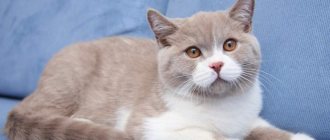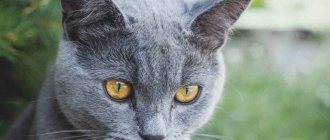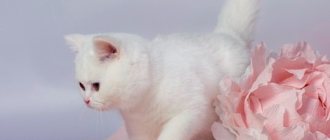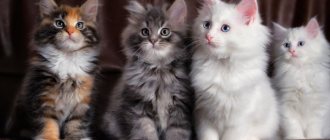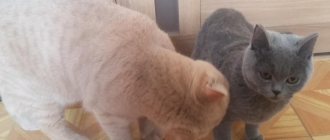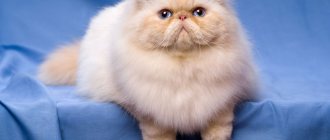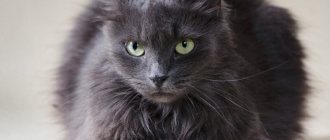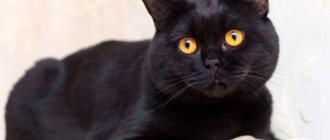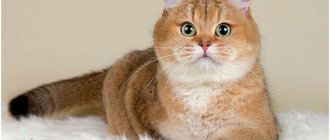Origin story
According to one version, British cats were brought by Roman legionnaires about 2000 years ago during the development of the islands of Great Britain. Another version interprets the French origin of this breed. There is no reliable data on who exactly brought these animals to the islands. History describes large gray cats among both Roman and French sailors, who were kept on ships to exterminate rodents. One way or another, the animals ended up in a separate territory, which allowed them to form their unique appearance. The damp and cold climate of England played a significant role in the evolution of the British breed. Due to constant winds and dampness, the wool became dense and thick. Hunting rodents has formed a strong body with developed muscles. Until the end of the 19th century, these animals were perceived as ordinary domestic cats.
In 1871, Harrison Weir organized the world's first cat show at the Crystal Palace in London . He proposed standardizing the breeds and introducing a point grading system. This time is considered the birth of the shorthaired breed . Harrison noticed that “aboriginal British” cats are different from others, they are larger, more massive, with special hair. In 1880, the first performance of these cats took place in London. In 1889, the first purebred shorthair cat was recognized. It was a white cat. In 1898, the first pedigree was issued. Until the beginning of the 20th century, selection did not divide shorthaired cats into British and European. The selection of representatives of the British breed began in the 30s of the 20th century. The official division of short-haired cats into British and European cats occurred in 1966.
The years of the First and Second World Wars affected the development of many breeds in Europe. The sharp decline in the number of British cats during the war and post-war times forced breeders to resort to interbreed matings to increase the population. Persian, exotic, chartreuse, Russian blue, European and American shorthairs were used in the breeding work. Thanks to the influx of new blood, by the beginning of the 20th century the British breed had several colors (solid, smoky, tabby, silver), although initially shorthaired cats in England were predominantly tabby. Crossing with the Persian breed quickly restored the population of large, strong animals, but fixed the gene for coat length, which gave a long-haired variation of the British breed, which is not recognized by all systems.
felinological system officially recognized the British Shorthair breed in 1980 as an independent breed with a ban on interbreed matings.
Appearance
A strong, large, powerful British cat is difficult to recognize. The characteristic appearance sets this breed apart from other cats.
The British Shorthair and Longhair breeds have a strong, broad-boned, muscular, compact, well-balanced, stocky, medium to large sized body. The weight of adult cats is 4-6 kg, males - 5-8 kg. The formation of the backbone and growth of the British is long, formed by 2-3 years. The chest is wide. The back is straight and short. The shoulders are broad and massive, as are the hips. The limbs are short and strong with rounded paws. The tail is straight, short, thick at the base and rounded at the tip. In general, the impression of everything is large, compact and round.
The British breed's head attracts attention, distinguishing it from other breeds. Round, large with a wide skull . The ears are small, set wide and low, rounded at the tips, well furred on the outside. In profile, the rounded forehead “cup” turns into a straight, short, wide nose with a noticeable transition. The muzzle is round with full cheeks. Cheekiness is a distinctive feature of the British breed. Looking at the animal, one gets the impression of a smile. The cheeks are more developed in cats; cats have a less pronounced “girlish oval”. The chin is strong, smooth, and the nose forms a vertical line. The eyes are set wide, large, round, wide open. Eye color varies from honey, orange, yellow to blue and green depending on the color. The cheekbones are wide. The neck is short, thick, powerful.
The British Shorthair breed has a short, dense (thick) coat that does not lie close to the body, is not too soft, and is of equal length throughout the entire body (average length is 2.4 mm), with a well-developed undercoat and a fine texture that creates a feeling of “plushness .
Representatives of the long-haired variety have medium-length, straight hair with good undercoat and dry guard hair. The collar and panties are developed, the tail pubescence is long and luxurious. White and color point colors are not recognized in the British Longhair breed .
British breed cat hair
Short, thick, shiny, dense, with a thick undercoat. Exotic shorthair cats are “hiding” in the ancestors of the British, known carriers of the hidden gene for long hair. Therefore, sometimes a long-haired miracle suddenly appears from two short-haired parents. The WCF system is now working to separate the two, and soon matings of shorthairs with longhairs will be prohibited.
Alas, of course, not everyone can boast of a short plush, real, thick, so that it would be impossible to reach the skin. Often the coat is still a bit long, especially in the back area near the tail and on the belly.
Colors
There are more than 200 colors . Such diversity was formed during the periods of formation and revival of the British breed. Color selection continues to this day with the constant development of the breed.
Color assessment includes coat color, pattern, eye color, paw pad color and nose color.
Solid colors
Uniform color throughout the body. Solid colors do not allow spots, shades, white hairs or patterns . The coat is thick, short, and every hair is evenly colored from root to tip. The eyes are only orange, yellow, amber, copper, honey. For white solids, not only yellow eye color is possible, blue or odd-eyed is also acceptable. There are 9 solid colors :
- Black(n)
- Blue (a)
- Chocolate (b)
- Lilac (c)
- Red (d)
- Cream (e)
- White (w)
- Cinnamon (o)
- Faun (p)
Tortoiseshell colors (Tortoise, Tortoiseshell, Turtle)
A combination of genetically black and red colors. Only cats have this coloring . With chromosomal mutations, cats with trisomy may be tortoiseshell, but they are unable to reproduce. The eyes are always yellow (gold, copper, orange). The coat is thick and dense. “Turtle” is a unique color for breeding, since these cats produce a wide range of colors in their offspring.
- Black tortoiseshell (f)
- Blue-cream tortoiseshell (g)
- Chocolate cream tortoiseshell (h)
- Lilac-cream tortoiseshell (j)
Patterned or tabby colors (Tabby).
There is a pattern against the background of the main color. There are three tabby colors : marbled (classic), brindle (mackerel), spotted (spotted). What unites this group is the color of the head. All of them have the features of a tabby - the outline of the nose, eyes, a “scarab” on the top of the head, the letter “M” on the forehead . Eye color can be any in accordance with the color.
- Marble color (code 22) – a clear pattern in the form of wide lines. Large stripes run along the back from the withers to the tail. Several necklaces are attached to the neck. A “butterfly” pattern can be formed on the shoulder blades and curls can be located on the sides. There are 2-3 wide rings on the tail.
- Brindle color (code 23) - stripes are narrower, starting from the center line on the back and descending in narrow stripes on the sides. The necklaces on the neck are thinner, the tail is striped.
- Spotted color (code 24) – against a lighter background of the main color, clear contrasting spots are evenly located throughout the body. They can be round, oblong, or in the form of rosettes. There are spots on the limbs and preferably on the tail (open rings are acceptable).
Tipped colors (tipping, tipping)
This is a group of colors in which the hair has two or several zones of coloring (necessarily light at the root and dark towards the tip). There are two types of tipping: with and without silver (gold).
Silver tipped colors (s is added to the encoding):
- Smoky color (smoke). British smoke-colored cats have short, thick, coarse hair, each hair of which is painted 2/3 pure silver (almost white) from the root, including the undercoat. The remaining 1/3 of the hair towards the tip is colored in the main color (black, blue, red, etc.). The eyes are necessarily copper or orange. The nose and paw pads correspond to the color of the main color. Smoky is always a solid color and has no pattern.
- Shaded color (shaded, 11). 1/6 of the hair at the tip is dyed in the main color, the rest is silver. British cats have green or bluish-green eyes. Orange or copper eyes are possible - this color is called Pewter, with the obligatory indication of the eye color coding. The nose and paw pads correspond to the color of the main color. Red, cream, tortoiseshell shaded colors are called Cameo.
- Veiled color (shell, 12). 1/8 of the hair at the tip is dyed, the rest is silver. Chinchillas have green eyes. The nose and paw pads correspond to the color of the main color. The first chinchilla was bred in 1970 by Norman Winder in England after crossing a Persian chinchilla and a British shorthair. In 1973, it was exhibited for the first time at a cat show, where the breed was named British Black with Tipping. The color was officially recognized in England in 1980. Red, cream, tortoiseshell veiled colors are called Cameo.
Golden tipped colors (y is added to the encoding):
- By analogy with silver colors, golden Britons can be shaded, when 1/6 of the hair is dyed at the tip, or veiled (1/8 of the hair). The main background is from pale apricot to dark brick with transitions to black. The nose is brick-colored, the paw pads are black or dark brown. The eyes are only green.
- Shaded and veiled colors are colors that seem to be coated. Looking at these cats, it seems as if the animal was sprinkled with black powder on top (or another color depending on the main color). They do not have closed rings on the neck and limbs, and there should be no residual pattern. A dark outline of the nose and eyes is required.
Color point colors
This group of colors is recognized only in the British Shorthair variety, not in the Longhair variety. Color-points have a lightened body and darker areas - points (areas with low body temperature - muzzle, tail, ears, limbs, scrotum). Like solid colors, they are distinguished: seal-point - black, blue-point - blue, chocolate-point - chocolate, lilac-point - lilac, red-point - red, cream-point - cream. Patterned tabby color points are not divided into classic ones, since the pattern is quite blurred. They are combined into the links-point color. The eye color of British pointing cats is only blue .
Bicolor colors
British shorthair and longhair breeds have all possible combinations of white and any main color - the bicolor group. Based on the area of white color from maximum to minimum, Vanov, Harlequins, and Bicolors are distinguished.
- Van has the maximum amount of white. Completely white body and limbs. Only the tail and the “cap” on the head are colored in the form of one or two separate spots (ideally), always affecting one ear.
- Harlequin. A fifth of the surface of the body is colored, the rest is white. The tail, the “cap” on the head with the obligatory inclusion of one ear, and spots on the back and/or sides must be colored. A white collar is required.
- Bicolor. Half of the entire surface of the body has a basic color and can be located in one continuous area or have an island appearance. For bicolors, the placement of white is mandatory on the muzzle in the form of an inverted “V”, on the chest and lower part of the body, on the hips and legs in the form of “slippers”. A white collar is also desirable.
The British breed is not allowed to have white medallions or white paws.
Character
The British breed is known for its balanced, aristocratic, intelligent character. They are quite independent and get along with people and other animals. Little curious. When guests come to the house, they try to hide in a secluded place in order to avoid unnecessary attention to their person.
They are not inclined to show aggression and are patient. They are trusting and attached to their owner, prefer to be close to him at a distance, but do not particularly like to be held. The British breed represents the ideal unobtrusive companion with a phlegmatic and calm temperament. This is a cat that is “on its own”, not fussy, measured, and a little talkative. Adult animals moderately love to play, are more lazy and prefer to sleep than run around the apartment. The British are smart, stubborn and calm, but touchy. Having offended your pet, you will have to win his favor with affection and attention.
"Big" in languages of the world
The easiest way to indicate your cat’s heroic status is to give him a “giant” nickname. Words in different languages of the world that mean “big”, “giant”:
- Big (English)
- Large (English)
- Grit (English)
- Gros (French)
- Grand (French)
- Grandy (Portuguese)
- Megalo (Greek)
- Kun (Korean)
- Goz (German)
- Grotto (Dutch)
- Oki (Japanese)
Persian cat Procrastinator
Care and maintenance
Unobtrusive, balanced British cats are easy to care for . Perhaps this is one of the most unpretentious breeds. The main task of the future owner is to maintain healthy coat quality, care for the ears and eyes. Due to the dense, thick undercoat, regular brushing is necessary, and daily during the shedding period.
Periodically you need to wash the animal using professional cosmetics. Regular grooming helps prevent the development of bezoars (wool stones in the animal’s digestive system), since the animal constantly licks itself, and wool entering the digestive tract can cause inflammation.
The British breed is moderate in its physical activity, therefore it is prone to obesity. A balanced diet, feeding regimen and regular exercise will allow the animal to be healthy and in great shape. Provide your pet with toys, a scratching post, and a climbing and play area.
Health
British cats are one of the healthiest cats, as they do not have any serious health problems. This breed has a good gene pool, so the British have been used to develop new breeds for many years. The only contraindication is drafts, since sitting in a draft can easily catch a cold. It is better to protect a pet of this breed from fatty foods, as there is a tendency to become overweight. To achieve an ideal balance in nutrition, you should switch the animal to ready-made canned and dry food. During the growth period, kittens, pregnant and lactating cats need to add natural food to industrial food.
The British breed is never crossed with the Scottish Fold, as the result is sick kittens with paralysis and dysplasia. In the 70s of the last century, a kitten with hemophilia was born, breeders certainly began work to identify carriers. As a result of the work, scientists found that the majority of British people are born with blood type A, and a minority have blood type B. Mating of animals with different blood groups leads to a conflict of Rh factors, that is, incompatibility. The British breed is characterized by late maturation. By the age of three to five, British kittens are fully mature, but thanks to this delay in development, they look young in adulthood. Representatives of this breed are long-lived, usually living up to 20 years.

